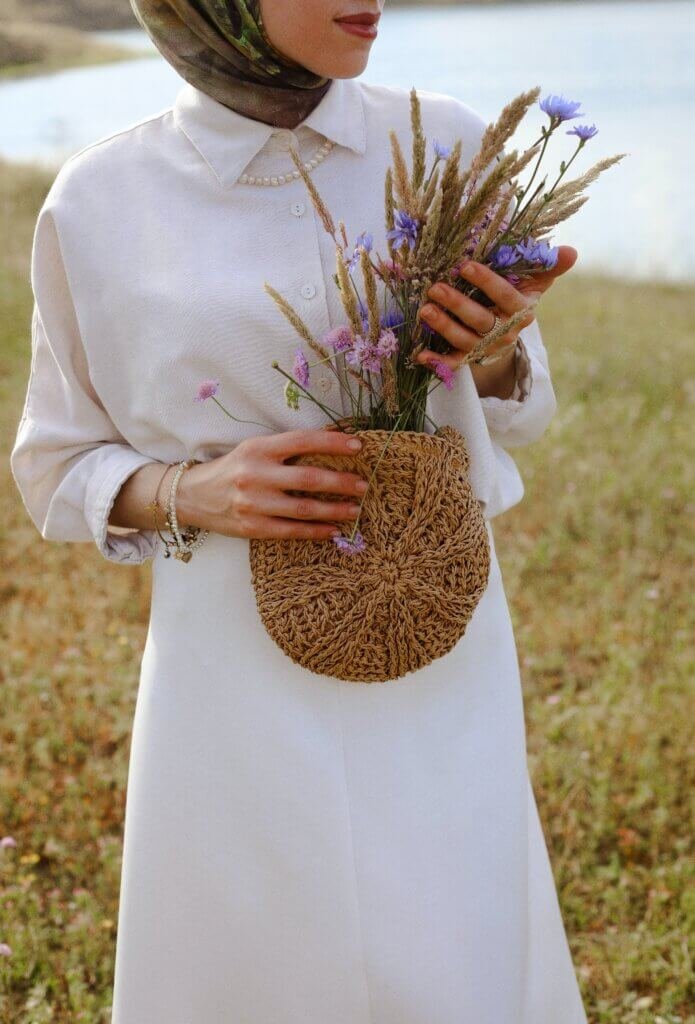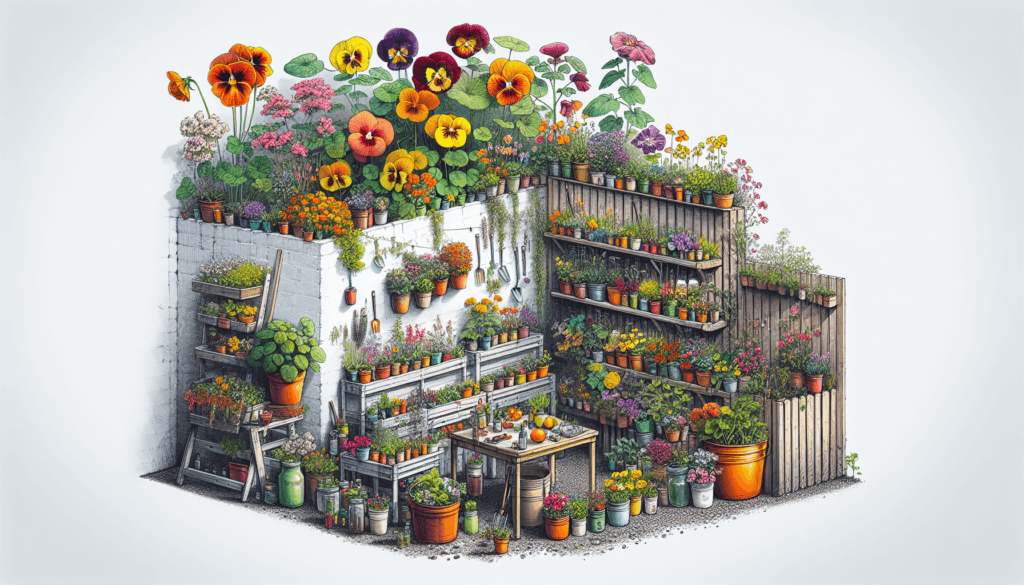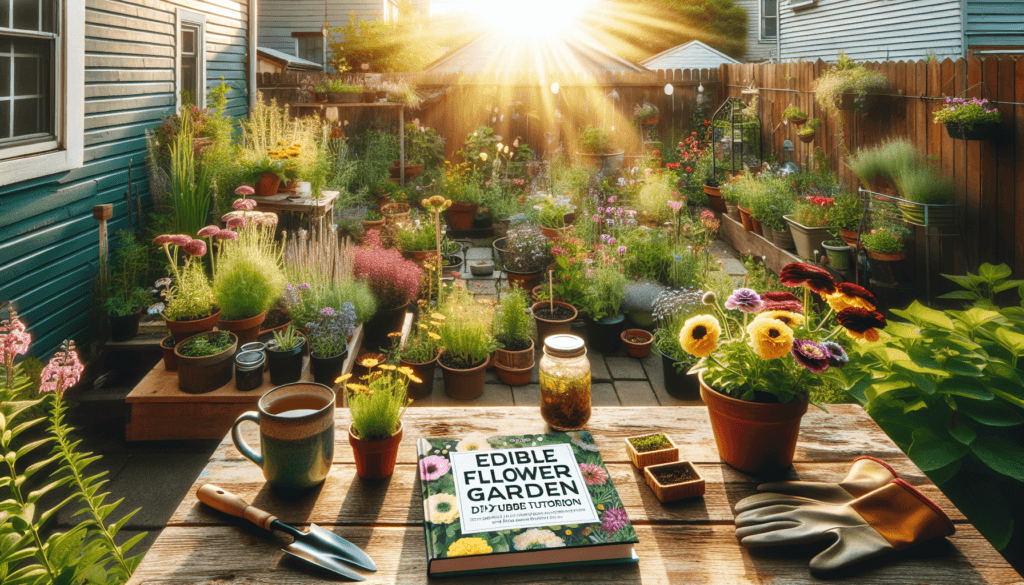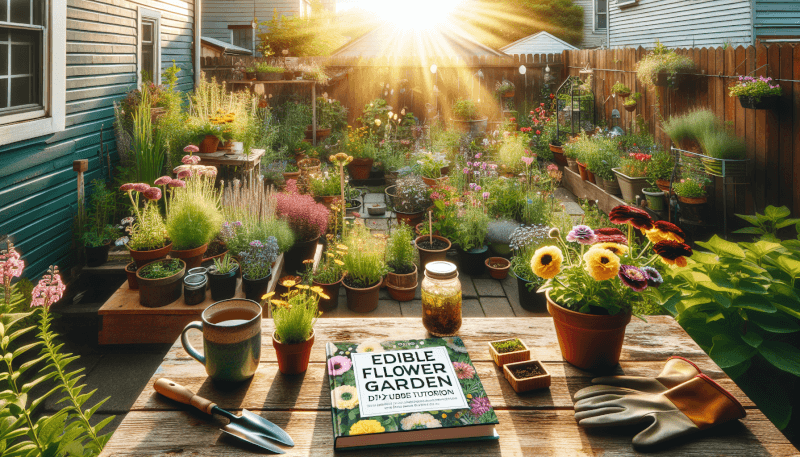Imagine transforming your small urban space into a beautiful edible flower garden bursting with colors and flavors. With these DIY ideas, you’ll discover innovative ways to grow and enjoy edible flowers right in your own backyard, balcony, or even windowsill. From creating vertical gardens to repurposing old containers, this article will guide you step by step in creating a stunning and sustainable edible flower garden that will not only bring aesthetic pleasure but also add a delightful twist to your culinary adventures.
Container Gardening
Container gardening is a fantastic option for urban dwellers who want to bring some greenery into their outdoor spaces. Whether you have a small balcony, a rooftop, or a tiny backyard, container gardening allows you to transform any space into a beautiful garden oasis. To get started, you’ll need to choose the right containers, select the ideal soil, and pick the right flowers.
Choosing the Right Containers
When it comes to choosing containers for your urban flower garden, there are a few factors to consider. First, you’ll want to think about the size of your space. If you have a small balcony, opt for compact containers that won’t take up too much room. If you have more space to work with, larger containers can add a stunning focal point to your garden. Additionally, consider the material of the containers. Clay pots are a classic choice, but plastic and metal containers can be lightweight and easy to move around if needed.
Selecting the Ideal Soil
The soil you choose for your container garden is crucial for the health and success of your flowers. Look for a high-quality potting mix that is specifically formulated for containers. This type of soil will be lightweight, well-draining, and provide the necessary nutrients for your plants. Avoid using garden soil, as it can be too heavy and may impede drainage. Don’t forget to water your plants regularly, as containers can dry out more quickly than plants in the ground.
Picking the Right Flowers
When it comes to selecting flowers for your container garden, the options are endless. Consider the amount of sunlight your space receives and choose flowers that thrive in those conditions. If your garden gets full sun, marigolds, zinnias, and petunias are excellent choices. For shadier spots, impatiens, begonias, and pansies will do well. Think about the colors and textures you want to incorporate into your garden, and don’t be afraid to mix and match different flower varieties for a stunning display.
Vertical Gardening
If you’re short on space but still want to have a vibrant flower garden, vertical gardening is the perfect solution. By utilizing walls and structures, you can create a vertical garden that adds beauty and greenery to your urban space. To get started, you’ll need to choose the right structure, select the perfect flowers, and learn how to maintain your vertical garden.
Choosing the Right Structure
When it comes to vertical gardening, the structure you choose is key. Consider the available space and the weight your structure will need to support. Options range from trellises and arbors to wall-mounted planters and hanging pockets. Choose a structure that not only fits your space but also complements your personal style. Some structures are designed specifically for climbing plants, while others are more versatile and allow for a variety of flowers or greenery.
Selecting the Perfect Flowers
When selecting flowers for your vertical garden, it’s important to choose plants that are well-suited for growing in a vertical setting. Look for trailing or climbing varieties that will cascade down your structure and create a stunning visual display. Consider flowers like morning glories, sweet potato vines, or nasturtiums. These plants have a natural ability to climb and will add a touch of elegance to your vertical garden. Make sure to select flowers that are suited to the light conditions your vertical garden receives.
Maintaining Vertical Gardens
Maintaining a vertical garden requires some extra attention compared to traditional gardens, but the results are worth the effort. Regular watering is essential to ensure your plants stay hydrated, especially during hot summer months. You may need to water your vertical garden more frequently due to the increased sun exposure and air circulation. Additionally, keep an eye out for any pests or diseases that may affect your plants. Pruning and deadheading are important tasks to keep your vertical garden looking tidy and vibrant.

Hanging Baskets
Hanging baskets are a charming way to bring beauty and color to your urban space. Whether you have a small balcony or a spacious patio, hanging baskets can be easily hung from hooks or railing, making them a great option for small areas. To create a stunning hanging basket garden, you’ll need to choose the right baskets, select the ideal flowers, and learn how to properly care for your hanging baskets.
Choosing the Right Baskets
When selecting hanging baskets for your flower garden, consider both aesthetics and functionality. Look for baskets that are lightweight, durable, and have sufficient drainage holes. You may opt for traditional wire hanging baskets or choose more contemporary options such as woven baskets or decorative planters. Consider the style of your outdoor space and choose baskets that complement the overall design.
Choosing the Ideal Flowers
When it comes to selecting flowers for your hanging baskets, there are a few factors to consider. First, consider the amount of sunlight your hanging baskets will receive. If your garden gets full sun, flowers like geraniums, petunias, and verbena will thrive. For shady or partially shaded areas, begonias, fuchsias, and impatiens are excellent choices. Additionally, consider the growth habit of the flowers. Opt for trailing or cascading varieties that will spill over the sides of the basket and create a lovely draping effect.
Watering and Care
Proper watering is essential for the health and success of your hanging basket garden. Hanging baskets tend to dry out more quickly than plants in the ground, so they may require more frequent watering. Check the moisture level of the soil regularly and water when it feels dry to the touch. Apply water slowly to ensure it reaches the root system thoroughly. Fertilize your hanging baskets regularly to provide the necessary nutrients for healthy growth. Deadhead spent flowers to encourage continuous blooming and remove any dead or damaged foliage as needed.
Window Boxes
Window boxes are a charming addition to any urban space, adding beauty and color to otherwise drab exteriors. Whether you have a small apartment with a single window or a large townhouse with multiple windows, window boxes allow you to create a mini garden oasis right outside your windows. To create a successful window box garden, you’ll need to choose the right window boxes, select the perfect flowers, and learn how to properly care for your window box gardens.
Choosing the Right Window Boxes
When it comes to choosing window boxes for your flower garden, there are a few factors to consider. First, think about the material of the window boxes. Common options include wood, plastic, or metal. Each material has its pros and cons, so choose one that fits your aesthetic preference and durability needs. Consider the size and shape of your windows, ensuring the window boxes are proportionate and won’t obstruct your view. Opt for window boxes with sufficient drainage holes to prevent waterlogging.
Selecting the Perfect Flowers
The flowers you choose for your window box garden can have a significant impact on the overall look and feel of your space. Consider the light conditions your windows receive and choose flowers that thrive in those conditions. If your windows get full sun, flowers like geraniums, marigolds, and petunias are excellent choices. For shadier areas, impatiens, begonias, and fuchsias will do well. Consider the color palette you want to create, and don’t be afraid to mix and match different flower varieties for a visually appealing display.
Caring for Window Box Gardens
Caring for your window box garden involves regular watering, fertilizing, and general maintenance. Window boxes can dry out quickly, especially during hot summer months, so make sure to water your plants regularly. Check the moisture level of the soil and water when it feels dry to the touch. Fertilize your window box garden regularly with a balanced, slow-release fertilizer to provide the necessary nutrients for healthy growth. Deadhead spent flowers and trim back any leggy or overgrown foliage to keep your plants looking tidy and vibrant.

Balcony Gardens
A balcony garden is a wonderful way to make the most of the space you have and create a peaceful retreat in the heart of the city. Whether you have a small balcony or a spacious terrace, a well-designed balcony garden can bring beauty, fragrance, and nature to your outdoor space. To optimize space on your balcony, choose the right flower varieties, and ensure proper watering and nutrient levels for your plants.
Optimizing Space on Your Balcony
When it comes to designing a balcony garden, space optimization is crucial. Start by assessing the available space and considering the different elements you want to incorporate, such as seating areas, planters, and vertical structures. Use the vertical space of your balcony by hanging baskets or installing trellises for climbing plants. Balcony railings can also serve as a perfect spot for small planters or window boxes. Utilize shelves or multi-tiered plant stands to maximize the horizontal space. By strategically arranging your plants and furniture, you can create an inviting and functional balcony garden.
Choosing the Right Flower Varieties
When choosing flower varieties for your balcony garden, consider the conditions your balcony receives, such as sunlight and exposure to wind. If your balcony is sunny, flowers such as geraniums, marigolds, and sunflowers are great choices. For partial shade or shadier balconies, impatiens, begonias, and fuchsias will thrive. Select flowers with different heights and growth habits to add visual interest and depth to your garden. Mix and match colors and textures to create a vibrant and captivating balcony garden.
Watering and Nutrients
Proper watering and nutrient management are crucial for the success of your balcony garden. Balcony gardens tend to dry out more quickly than traditional gardens, so regular watering is essential. Check the moisture level of the soil and water when it feels dry to the touch. Consider investing in self-watering containers or installing a drip irrigation system to ensure consistent moisture for your plants. Fertilize your balcony garden regularly with a balanced, water-soluble fertilizer to provide the necessary nutrients. Pay attention to any specific nutrient requirements of the flower varieties you choose and adjust your fertilization routine accordingly.
Indoor Edible Flower Gardens
Just because you live in an urban space doesn’t mean you can’t enjoy the beauty and flavors of edible flowers. Indoor edible flower gardens are a fantastic way to bring nature indoors and add a unique touch to your culinary creations. To create a successful indoor edible flower garden, choose the right indoor plants, provide adequate light, and ensure proper watering and fertilizing.
Choosing the Right Indoor Plants
When selecting indoor plants for your edible flower garden, consider the growing conditions inside your home. Most edible flowers thrive in bright, indirect light, so choose a spot near a sunny window or install grow lights to provide sufficient light for your plants. Choose compact plants that are well-suited for indoor environments and have a naturally bushy or cascading growth habit. Some popular edible flower options for indoor gardens include nasturtiums, pansies, violets, and calendulas.
Providing Adequate Light
Light is one of the most important factors for the successful growth of indoor edible flowers. Most flowering plants require bright, indirect light for at least six to eight hours a day. Place your plants near a south or west-facing window where they can receive ample sunlight. If your home doesn’t have enough natural light, consider installing grow lights to supplement the light requirements of your plants. Adjust the height and intensity of the lights according to the specific needs of your flower varieties.
Watering and Fertilizing
Proper watering and fertilizing are essential for the health and productivity of your indoor edible flower garden. Avoid overwatering, as this can lead to root rot and other issues. Check the moisture level of the soil regularly and water when it feels dry to the touch. Ensure proper drainage by choosing well-draining containers with drainage holes. Fertilize your plants regularly with a balanced, water-soluble fertilizer formulated for edible flowers. Follow the instructions on the fertilizer packaging and adjust the frequency based on the specific needs of your plants.

Creative Planters for Small Spaces
If you’re looking for unique and inventive ways to add greenery to your urban space, consider creative planters for small spaces. From repurposing everyday items to creating vertical planters and miniature fairy gardens, there are countless possibilities to bring your imagination to life.
Repurposing Everyday Items
One of the easiest and most cost-effective ways to create creative planters for small spaces is by repurposing everyday items. Consider using old teapots, tin cans, wooden crates, or even mismatched shoes as planters. With a bit of creativity and a touch of DIY spirit, you can turn these items into charming and whimsical planters that add personality to your space. Just make sure to provide drainage holes and use appropriate soil for your plants’ health and well-being.
Creative Vertical Planters
Vertical planters are a fantastic solution for small spaces, allowing you to maximize your greenery without taking up valuable floor space. Consider installing a living wall with pockets made of felt or using a trellis system to create a vertical garden. You can also repurpose old bookshelves or wooden pallets as vertical planters. This not only adds visual interest to your space but also allows you to grow a larger variety of plants. Mix and match different flower varieties and foliage to create a stunning living art piece in your urban space.
Miniature Fairy Gardens
For a touch of enchantment, consider creating miniature fairy gardens in small containers or planters. Use small, low-growing plants like mosses, miniature ferns, and tiny flowering plants to create a whimsical landscape. Add miniature fairy figurines, tiny furniture, and decorative stones to bring the garden to life. The small size of these gardens makes them perfect for windowsills, balconies, or even indoor spaces. Get creative with your design and let your imagination run wild. These miniature fairy gardens are sure to bring a little magic into your urban space.
Companion Planting
Companion planting is a gardening technique that involves planting different plants together to benefit one another. Certain flowers have properties that can repel pests, attract beneficial insects, or enhance the flavor of neighboring plants. Understanding companion planting and choosing complementary flowers can result in a healthier and more productive urban flower garden.
Understanding Companion Planting
Companion planting is based on the concept that certain plants can provide benefits to one another when grown in close proximity. For example, marigolds are known to repel aphids and attract beneficial insects like ladybugs, which feed on pests. Basil, when planted near tomatoes, can enhance the flavor of the fruit and deter certain pests. Learning about the companion planting relationships between different flowers and vegetables can help you create a harmonious and thriving garden.
Choosing Complementary Flowers
When practicing companion planting in your urban flower garden, consider the specific needs and benefits of each flower variety. Some flowers, like petunias and marigolds, are known for their pest-repellent properties and can be beneficial when planted near susceptible plants. Other flowers, such as borage and yarrow, attract pollinators like bees and butterflies, improving the overall pollination of your garden. Consider the growth habit, sunlight requirements, and soil preferences of each flower variety to ensure they are compatible when planted together.
Beneficial Relationships
Companion planting can create positive relationships between plants that benefit each other in various ways. Some flowers, like lavender, can attract beneficial insects while repelling pests. Other flowers, such as sunflowers, can provide shade and support for climbing plants like beans or peas. Additionally, planting flowers with different blooming periods can provide a continuous source of nectar and pollen for pollinators throughout the growing season. Understanding these beneficial relationships and implementing companion planting techniques can help you achieve a thriving and sustainable urban flower garden.

Edible Flowers for Every Season
Edible flowers not only add beauty to your urban flower garden, but they also offer an opportunity to enhance your culinary creations. By choosing the right edible flowers for each season, you can enjoy a continuous supply of fresh and flavorful blooms throughout the year.
Spring Edible Flowers
In the spring, a variety of colorful and flavorful edible flowers can be incorporated into your urban garden. Flowers like violets, pansies, and lilacs are not only visually stunning but also have a delicate floral flavor that can be used in salads, desserts, and beverages. Dandelion flowers, with their slightly bitter taste, can be added to salads or turned into dandelion jelly. Nasturtiums, known for their peppery flavor, can add a vibrant touch to your spring dishes.
Summer Edible Flowers
Summer brings an abundance of edible flowers that can elevate your culinary creations. Calendulas, with their bright orange petals, have a slightly spicy flavor and can be used in salads, soups, or as a garnish. Sunflowers, when young and tender, have a mild nutty taste and can be added to salads or used to make sunflower butter. Zucchini blossoms, delicate and slightly sweet, are commonly stuffed or used in fritters. Explore the wide range of edible flowers available in the summertime and let your creativity flourish in the kitchen.
Fall and Winter Edible Flowers
As the seasons transition into fall and winter, the selection of edible flowers becomes more limited. However, there are still wonderful options to choose from. Pansies and violas, which can tolerate cooler temperatures, continue to bloom and offer their beautiful petals for culinary delights. Chrysanthemums, often used in tea or stir-fries in Asian cuisine, can add a unique flavor to your autumn dishes. Consider using edible flowers as garnishes, candying them for sweet treats, or infusing them into oils or vinegars to enjoy their flavors throughout the colder months.
Tips for Successful Urban Flower Gardens
Creating and maintaining a successful urban flower garden requires some careful planning and thoughtful consideration. By considering sunlight conditions, balancing watering and drainage, and maintaining proper nutrient levels, you can ensure your urban flower garden thrives and brings joy to your urban space.
Considering Sunlight Conditions
Sunlight is a crucial factor when it comes to the success of your urban flower garden. Before choosing flowers for your garden, assess the amount of sunlight your outdoor space receives. Observe the sun patterns throughout the day and identify areas with full sun, partial shade, or full shade. Different flower varieties have different light requirements, so choose flowers that are well-suited for the light conditions of your urban space. Consider using shade-loving plants or using structures like trellises or umbrellas to create shade in areas with intense afternoon sun.
Balancing Watering and Drainage
Proper watering and drainage are essential for the health of your urban flower garden. While it’s important to keep your flowers hydrated, overwatering can lead to root rot and other issues. Consider the type of soil you’re using and choose a well-draining potting mix to ensure excess water can drain away easily. Monitor the moisture level of the soil regularly and water when it feels dry to the touch. Adjust your watering routine based on the weather conditions, as plants may require more water during hot and dry periods.
Maintaining Proper Nutrient Levels
Fertilizing your urban flower garden is crucial for providing the necessary nutrients for healthy growth and blooming. Choose a balanced, slow-release fertilizer specifically formulated for flowers. Follow the instructions on the fertilizer packaging and adjust the frequency of application based on the needs of your plants. Regularly check for nutrient deficiencies, such as yellowing leaves or poor flowering, and address them accordingly. Additionally, consider using organic fertilizers or compost to provide natural sources of nutrients for your garden.
In conclusion, urban flower gardens offer a fantastic opportunity to bring nature, beauty, and fragrance into your urban spaces. Whether you opt for container gardening, vertical gardening, hanging baskets, window boxes, balcony gardens, indoor edible flower gardens, creative planters, companion planting, or edible flowers for every season, there are endless possibilities to create a flourishing urban garden. By following the tips and guidelines provided, you can ensure the success of your urban flower garden and enjoy the serenity and joy it brings to your urban lifestyle. So go ahead, get your hands dirty, and let your urban flower garden bloom!



